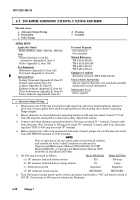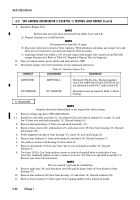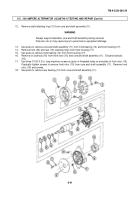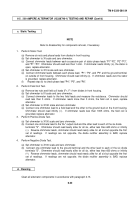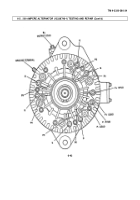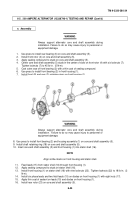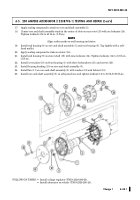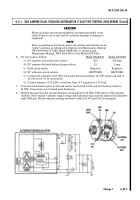TM-9-2320-280-34 - Page 373 of 1258
TM 9-2320-280-34
6 - 4 4 . 4
Change 1
Table 6-D. No-Load Test.
Table 6-E. Full-Load Test.
AMPS
28VDC
14VDC
DIAGNOSIS
162-200
21-25
10.5-12.5
Test bench battery is discharged (or defective). Allow
to charge (or replace).
162-200
26-30
13-15
Give time to stabilize while monitoring VOLTS. If
VOLTS rise above normal range (26-30 volts),
regulator and/or tube assembly must be replaced. If
AMPS fall, charging system is OK.
162-200
31-35
15.5-17.5
STOP TEST. Regulator and/or tube assembly must be
replaced. Refer to static testing, task c.
80-118
21-25
10.5-12.5
Alternator and/or regulator must be repaired or
replaced. Refer to table 6-F.
80-118
26-30
13-15
Regulator OK. Refer to table 6-E.
80-118
31-35
15.5-17.5
STOP TEST. Test bench malfunction or wiring error.
AMPS
28VDC
14VDC
DIAGNOSIS
162-200
21-25
10.5-12.5
Test bench battery is discharged (or defective).
Allow to charge (or replace).
162-200
26-30
13-15
Charging system OK.
162-200
31-35
15.5-17.5
STOP TEST. Regulator and/or tube assembly
must be replaced. Refer to static testing, task c.
80-118
21-25
10.5-12.5
Alternator and/or regulator must be replaced.
Refer to table 6-G.
80-118
26-30
13-15
Increase load.
80-118
31-35
15.5-17.5
STOP TEST. Test bench malfunction or wiring
error.
NOT E
• When tachometer reaches 3000 rpm, green lamp should go off,
indicating proper charging from alternator.
• Normal voltage range is 26-30 VDC. High amperage is +10 percent
over the rated alternator output of 162 amps at 5000 rpm.
9.
Perform full-load test. Ensure all load switches are in ON position on 500 amp test stand, and
increase alternator speed to 5000 rpm. Set load to 81 amps/min; record results. Refer to table 6-E,
Full-Load Test, for diagnosis.
10.
For alternator speed and current output tracking values, refer to table 6-F.
11.
Perform regulator bypass test. Prepare alternator as in full-load test.
6-5.1. 200 AMPERE DUAL VOLTAGE ALTERNATOR (12447109) TESTING AND REPAIR (Cont'd)
Back to Top

